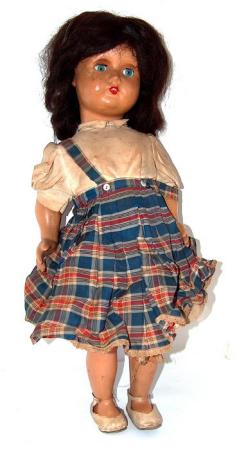| Dolls only made in Argentina | « previous | index | next » |
|
Marilu Doll made in Argentina
Dolls only made in Argentina.
The story of Marilu is the story of hundreds of Argentine girls who grew up playing with these dolls, who sowed those tiny gorgeous outfits taylormade for their own doll with those unique Parisian flavored model-patterns that appeared in the monthly issue of the Marilu Magazine.
According to the experts it all began back in 1932 when Alicia Larguia talked with the German doll manufacturers Kammer & Reinhardt for a custom made porcelain doll. This was the genesis of a broad generation of sophisticated top notch dolls made for the luxury Argentinean consumption. Soon after the first models were made the doll was indeed a true success among the upper argentine society. By 1936 the production was taken over by another German firm: Konig and Wernicke. It would take until 1940 till a fully Argentine firm began to conceive and coordinate the production of these sophisticated gorgeous dolls. Early in 1940 the local Bebilandia was the sole company in charge of producing and marketing the outstanding Marilu.
The Marilu dolls were true artistic creations, handcrafted and decorated in detail to the extent of featuring expressions and twinkling eyes…
These were paste and wooden made dolls; the hair was natural and original; the eyes –one of the most outstanding features- were light blue sleepy looking. However the extreme detail within the lips, teeth, and tongue were the top detail references. Even back in 1940 this was the most sophisticated and valuable Marilu doll available. Without a doubt it still is, for that careful detail within the finishing touches is indeed an appreciated feature both for collectors and amateurs who enjoy the beauty within the artwork.
This particular model had wooden legs and arms that had been coated with a couple of delicate paste layers to create a very finished real look. The fine technique for the articulations movements is outstanding; shoulders, elbows and hands move and rotate naturally.
There’s a unique trademark sign that helps to identify the original Marilu dolls, and that is a blue stamp on the back of the neck –generally hidden by the long and beautiful hair-.
Marilu dolls are 55 centimeters tall by 20 centimeters wide and 10 depth; this standardized size was the key to the other outstanding feature that came along with the beautiful doll: a stupendous, chic and sophisticated wardrobe. Featuring the latest stylish addition to the Parisian aesthetic trend or the newest Argentine creation a broad doll sized wardrobe kept up-to-date the doll image with which Society girls identified deeply.
In those days the French feminine influence was without a doubt the strongest female role model. Considering this, we can trace a deep and strong influence that the French Bluette dolls had on the conception and development of Marilu. Alike the French weekly magazine La Semain the Suzette, Marilu Magazine was also a trend setter. These magazines were solely issued for the young female public; it was indeed the best proven proper method to assist these young girls into the feminine world of the time. Cuisine, sewing, bricolage, fairy tale stories and girly games were the index options featured by these publications. This super chic edition together and the oh-my-god fashionable doll wardrobe teamed up with the Marilu store for the moms and young women that alike the doll outfits were at the avant-garde of stylish clothing in Buenos Aires.
Indeed Marilu was a trend setter for the feminine Argentine public.
When researching the origins of those superb tailored mini outfits Marilu Dolls modeled we had the pleasure of meeting the relatives of one of the first Marilu tailors: Bid and Rene. They were so pleased with the research we had carried on trying to recover the story of Marilu from oblivion in the national and international market.
They told us the insight story of the Marilu wardrobe in the early days of it’s conception.
The Bidegain family who lived in Argentina was in the shoe making business –this was a family craft that was passed generation to generation-. Jean Hiriart who was Georges Bidegain's brother-in-law owned a shoe store called "Les Bebes" on Florida Ave in downtown Buenos Aires’ hottest and most sophisticated shopping area. A sunny morning while he was working on a great pair of shoes a beautiful woman walked in and asked Mr. Hiriart if he would make shoes for a doll that she was making. He said he was too into his shoemaking work but thought that his apprentice Georges Bidegain, would make them for her. Georges and his wife, Denise de Jaureguiberry, and her sister, Marguerite started making shoes and clothes for the woman's doll. The doll was "Marilu."
Unfortunately when the Bidegain family left the Argentine Republic to their motherland France they had a trunk full of their own production and the Marilu dolls that was stolen the minute they set foot on the old continent.
Nonetheless, in spite of the fact that the newer Bidegain generations couldn’t enjoy first hand these gorgeous dolls, they had left the world’s doll lovers a true and extremely valuable gift of sophistication, beauty and quality products for children.
Bob Frassinetti: For more information: Email: Bob Frassinetti. Press here to go back to web blog:Daily Updates on Art, Antiques, Collectibles as well as travel information for Buenos Aires, Argentina. Phone me thru Skype, ID: Bob Frassinetti or you can also chat with me thru Yahoo, press here:
Yahoo Contact
Find me on MySpace.
Updated 2009 Copyright Bob Frassinetti, travelling for arts and antiques in the south of South America,.......
|
